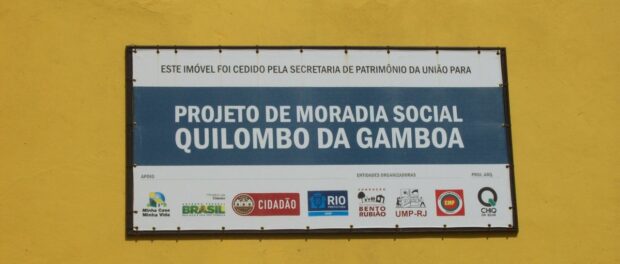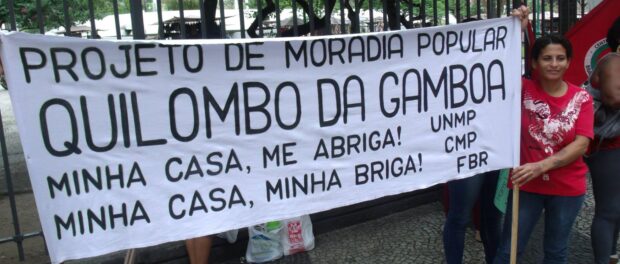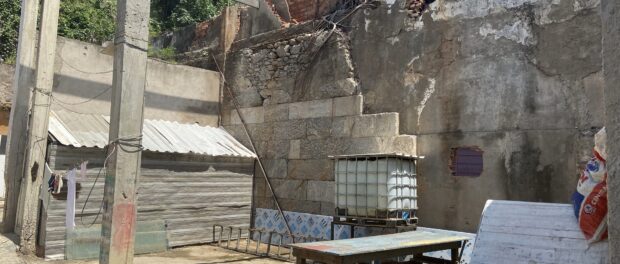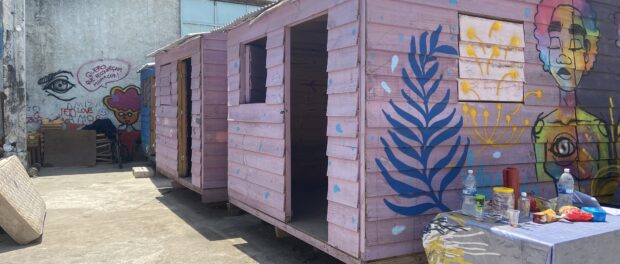
This is the first of two articles on the struggle of two projects for affordable housing in Rio de Janeiro’s Port Region, situated in the city’s downtown Centro. Despite being an area that was, for many decades, primarily occupied by low-income residents, the Port Region began to be coveted by real estate speculators after the Porto Maravilha urban renewal project began, and since then, the low-income population’s ability to remain in the region is constantly under threat. This first article covers the case of the popular movement-acquired Quilombo da Gamboa, aiming to better understand the over decade-long struggle for affordable housing in Rio’s Centro. For the second article, click here.
The popular housing project Quilombo da Gamboa emerged in 2008, the result of a national mobilization by housing rights movements, in order to realize the fulfillment of the Constitutionally-mandated social function of federal buildings through the production of social interest housing. Since then, the Gamboa project has emerged as an alternative for some residents of the extinct Quilombo das Guerreiras occupation, which suffered from internal strains heightened by external pressures driven by the context of Porto Maravilha. At the site of the Quilombo das Guerreiras occupation, there were plans to erect Rio’s Trump Towers, which would have been a physical and symbolic mark on that part of the city.
Through the struggle and demands of social movements active in Rio—the Center for Popular Movements (CMP) and the Union for Popular Housing (UMP)—members of Quilombo das Guerreiras obtained the piece of land currently destined for Quilombo da Gamboa, in the neighborhood by the same name, Gamboa. After obtaining the concession of use title to the land, which belongs to the federal government, they managed to get the project included in the Minha Casa Minha Vida-Entitades public housing program, signing a contract with Brazil’s national housing bank, Caixa Econômica Federal, in 2015.
The signing of the contract, however, did not represent the end of the struggle for residents and movements involved in the project. Within the area covered by Porto Maravilha’s Urban Operation Consortium‘s development plan, the project suffered successive attempts to occupy the land that was designated for it. These came from a diverse range of actors: from businessmen linked to the entertainment sector to service providers who were betting on the rapid occupation of the area by corporate ventures aimed at the middle and upper classes. On top of the disputes linked to land occupation, the project had to deal with the bureaucracies of Caixa Econômica Federal and the changes in direction at the federal level, all of which have prevented the agreed-upon funds from being released to this day.
Despite the countless challenges, Quilombo da Gamboa is considered by the ten families that currently occupy the land as a space of struggle and resistance, as well as their last hope for guaranteeing their own home in downtown Rio. They point out that the region benefits from transport infrastructure, public services, and, most importantly, is close to the areas that most offer employment in the city, which allows residents to work without paying transportation fees to and from Rio’s outskirts (which is expensive and takes hours per day, making family life more difficult).
The dispute over the city’s central area intensified beginning in 2011, when Porto Maravilha announced its intent to attract over 100,000 people, in 10 years, to a fully modernized port area that would be destined for the middle and upper classes, in view of the lack of public housing projects capable of guaranteeing the presence of poorer people who have always lived in the region. There were some debates in the following years on how to remedy the situation, to no avail. Despite the relative failure of the project, the region became hostile to poorer residents, as it is still seen as a promising area for speculative development by entrepreneurs and real estate agents.
This vision, which is shared by the authorities and by a significant part of society, has a direct impact on projects such as Quilombo da Gamboa, which remain under threat and continue their tireless struggle for permanent residence. Residents recount fears of having to leave the land designated for the project as they have no other housing options, especially as it is impossible for them to pay rent in the current economic crisis. This at a moment in which housing is a question of life or death, more than ever.
Despite their challenges and fears, residents have dreams for Quilombo da Gamboa. Amongst the most frequently mentioned is that of carrying out plans for construction of five buildings, with 116 apartments, which would serve more families who are vulnerable and guarantee decent infrastructure for their children, with areas for leisure and communal living.
This is the first of two articles on the struggle of two projects for affordable housing in Rio de Janeiro’s Port Region, situated in the city’s downtown Centro. For the second article, click here.



